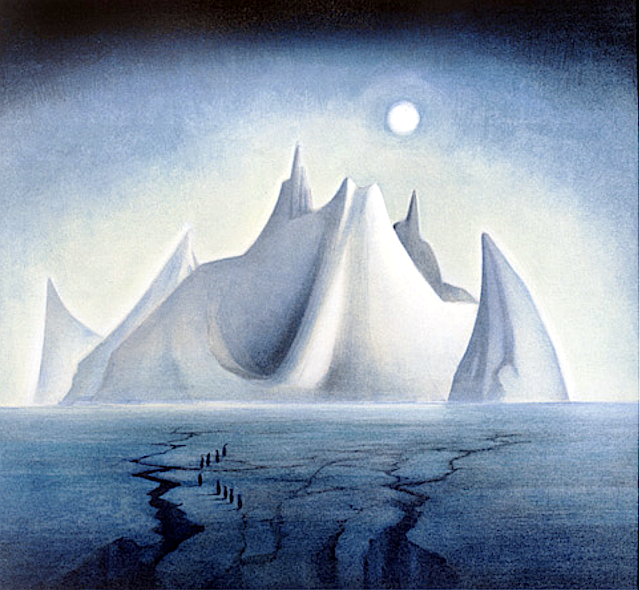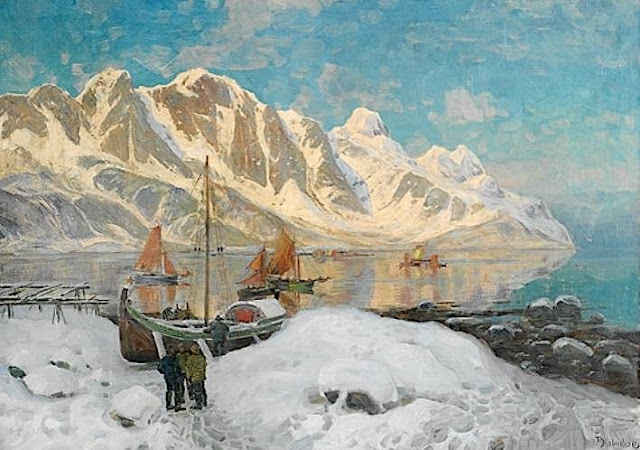Le Higravstinden / Iles Lofoten (1,148 m- 3766 ft)
Norvège
In " Northern Lights. Study from North Norway" (c. 1901-09) huile sur toile 46 x 55 cm. Nationalmuseum, Stockholm
Le Higravstinden (1, 148 m- 3,766 ft) )est le plus haut sommet de l'archipel des Lofoten appartenant à la Norvège. Il se situe sur l'île d'Austvågøya. Les îles Lofoten se situent au large de Bodø, au nord du cercle polaire, entre la mer de Norvège et le Vestfjord, bras de mer poissonneux qui les sépare du continent. Les Lofoten sont caractérisées par des montagnes et des pics, des baies protégées et des côtes découpées. Si le nord de l'archipel fournit des étendues herbeuses relativement importantes, le relief est de plus en plus escarpé au fur et à mesure que l'on descend vers le sud, laissant place à une forme caractéristique d'« Alpes dans la mer », où seule une étroite bande côtière est assez habitable. À Svolvær, le jour polaire se produit du 25 mai au 17 juillet, et la nuit polaire du 4 décembre au 7 janvier. À Leknes, le soleil ne descend pas sous l'horizon entre le 26 mai et le 17 juillet. La nuit est ininterrompue du 9 décembre au 4 janvier. Des aerores boréales et des phénomènes lumineux inhabituels sous d'autres latitude terrestres peuvent alors être observés, comme c'est le cas sur cette toile de Anna Katarina BIoberg
L'artiste
Anna Katarina Boberg (1864-1935), suédoise, mariée à l'architecte Ferdinand Boberg est née Anna Scholander, fille de l'architecte Fredrik Wilhelm Scholander. Elle est la sixième de sept enfants. Elle étudie le français et, durant une courte période, étudie la peinture à l'Académie Julian à Paris. En 1905, Anna Boberg rencontre Margaret de Connaught, princesse héritière de Suède, qui était aussi peintre. Un rencontre et amitié qui mènera les deux femmes chevalier en bandouliere dans dans la région de Stockholm ou elles peignirent ensemble de nombreux paysages. Mais le grand œuvre d'Anna Boberg fut le sans conteste sa peinture des paysages des Iles Lofoten qu'elle découvrit pour la première fois en 1901 et et qu'elle ne cessa de peindre pendant les 33 années suivantes. Les glaciers, l'océan, le soleil de minuit et ses lumières furent d'inépuisables sources d'inspiration pour elle. En 1925, elle s'installe avec son mari à Paris où ils resteront quatre années avant de retourner à Stockholm. Ils vvrrons désormais dans la villa Tin Grand à Södermalm jusqu’à la mort d'Anna Boberg en 1935. Anna Boberg fut une artiste polyvalente. Elle peignit aussi bien des tableaux de montagnes que des panneaux décoratifs,pour les salles à manger des grands hôtels. Elle a également conçu la céramique « Vase Peacock » pour Rörstrand en 1897. Elle a aussi travaillé le verre et le tissu avec un égal bonheur.
_________________________________________
2023 - Wandering Vertexes ....
Errant au-dessus des Sommets Silencieux...
Un blog de Francis Rousseau
%20%20Northern%20Lights.%20Study%20from%20North%20Norway%20(c.%201901-09)%20Oil%20on%20canvas,%2046%20x%2055%20cm.%20%20Nationalmuseum,%20Stockholm.jpg)


















